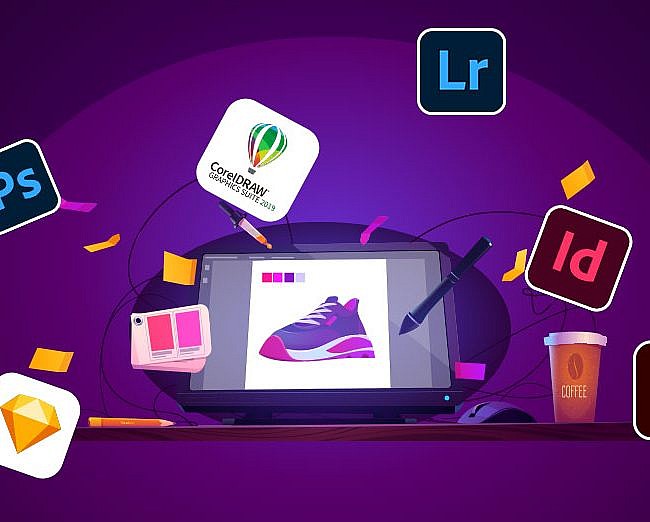With the explosion of AI in recent years, it’s easy to talk about it regarding how artificial intelligence will replace humanity, regardless of the profession. In fact, people will always fear something new before it becomes common. Designers are no different. AI is beginning to trickle into our process, albeit a little at a time, but it’s making an impact. From easier automation of menial task to broader design strokes—AI has the potential to open up the graphic design process in a way we haven’t seen since Apple’s first computer hit the market.
The truth of the matter is, AI isn’t technically new. We’ve been working with it, evolving it, and developing new uses for it since the 1950’s. John McCarthy, co-founder of MIT AI Lab & Stanford AI Lab, said in 1955 that AI can be described as: “making machines do things that require intelligence if done by man.”
When described this simply, it can mean a host of things from your oven cooking your food for you, to spellchecker on your computer and phone, to Google Maps, and the current use of Siri, Bixby, or Cortana on your phone—and more. Designers like to believe it’s creativity that sets them apart and makes their work specialized—but what happens when AI can do all the technical work for you—and maybe even better than you?
What AI Brings to the Design Table
AI and designers are old friends. Starting with architecture back in the 1960’s with architecture design. In 1961, Marvin Minsky, co-founder of the MIT AI Lab said, “I believe…that we are on the threshold of an era that will be strongly influenced, and quite possibly dominated, by intelligent problem-solving machines.”
That was over fifty-five years ago. While he was technically right, the full evolution of society takes time. Here are a few ways we can expect the latest AI developments to affect the way we work and design:
Symbiotic Design
Over the coming years, AI will have to undergo some schooling. While it can do a good many things, it’s not yet reached the all-knowing and humanesque qualities we consider when we think about AI. Science fiction aside, designers will be and already are, teaching AI platforms how to think more like us. As these AI tools gain more intelligence, their algorithms become more advanced and more precise. This will, in turn, help the AI to work with us to create designs in new and unexpected ways. The designers will then be able to mold the creations produced by AI to produce quality results.
Evolutionary Opportunity
Taking symbiotic design, a step further, we are already seeing AI capable of producing designs, sans designer. It doesn’t necessarily mean the designs are perfect, but they do offer a leap forward in the realm of creation and automation. For the foreseeable future, designers shouldn’t worry about their jobs, but perhaps look more into how these AI tools might help them design faster, as well as produce surprising results they hadn’t thought of without the aid of the AI. Here are a few platforms currently incorporating AI to make the process of design easier:
- The Grid – The Grid launched in 2014, and is an AI web designing program. The AI, the Molly, has built hundreds of thousands of web pages, according to their site. However, the site still has mixed reviews as they iron out the kinks. This type of design is still in its infancy so that we can expect more capability in the coming years.
- Wix ADI – Similar to the Grid, Wix ADI builds websites. Using their algorithms and a few answered questions by the client, Wix ADI can build websites tailored to the needs and desires of the client. A designer or the client can still go in and continue to tailor the website as they see fit.
- Firedrop – Another website and landing page platform using AI is Firedrop. It uses the AI assistant, Sacha, to design with ease. Sacha designs via voice commands; no drag and drop or toolbars necessary. Once the designer gets used to the flow of this, simple website design may be the intuitive interface needed to speed up the design process.
- DesignScape – With DesignScape, they take AI web design on a different path. Rather than designing everything for you, their AI interface is more of an interactive teacher; offering hints and tips to designers as another great example of symbiotic design.
- Adobe – Adobe’s new AI, Sensei, is just in its infancy as well, but its uses can, and likely will be, far-reaching. As Adobe continues to develop Sensei, we’ll see design tasks happening within the suite of programs being managed far more quickly than ever before.
Artificial Intelligence and design can certainly go hand-in-hand. We can see how it’s already changing the way of design. The question is, will we embrace its capabilities—or fear it? Either way, it’s unlikely AI will be going away anytime soon. In the coming years, we’ll certainly see more of the symbiotic relationship—as designer teaches AI, and AI sparks new creative ideas for the designer. While platforms like the Grid, Firedrop, and Wix ADI would like for AI to be all-encompassing, for the time being, it’s safe to say a designer’s eye will be needed to make final tweaks, and offer up the soul of design.
At Artwork Abode, we keep our designer’s eye in the future, while continuing to design high-quality pieces for our clients. If you’d like to talk about how we incorporate AI into our current process, or how we foresee using it in the future, contact us today. We’d love to show you our portfolio and talk about your upcoming design requirements. Together we can come up with a plan to take your designs into the future.
– Artwork Abode
Artwork Abode



